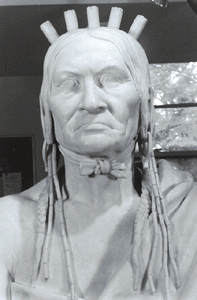|
Home Members Past Hearings Briefings Legislation Press History Links Staff Internships Archives |
 About the Senate Committee System Jurisdiction and Authority of the Committee on Indian Affairs History of the Committee on Indian Affairs Summary. In 1977, the Senate re-established the Committee on Indian Affairs,
making it a temporary Select Committee [February 4, 1977, S. Res. 4, § 105, 95th Congress.,
1st Sess. (1977), as amended]. The Select Committee was to disband at the close of the 95th
Congress, but following several term extensions, the Senate voted to make the Committee
permanent on June 6, 1984. The Committee has jurisdiction to study the unique problems of
American Indian, Native Hawaiian, and Alaska Native peoples and to propose legislation to
alleviate these difficulties. These issues include, but are not limited to, Indian education,
economic development, land management, trust responsibilities, health care, and claims against
the United States. Additionally, all legislation proposed by Members of the Senate that
specifically pertains to American Indians, Native Hawaiians, or Alaska Natives is under the
jurisdiction of the Committee.
History. Until 1946, when a legislative reorganization act abolished both the
House and Senate Committees on Indian Affairs, the Senate Committee on Indian Affairs had
been in existence since the early 19th century. After 1946, Indian affairs legislative and
oversight jurisdiction was vested in subcommittees of the Interior and Insular Affairs
Committees of the House of Representatives and the Senate. While this subcommittee
arrangement may not have specifically reflected a diminishment of the consideration given
Indian affairs by the Congress, the revised arrangement historically coincided with a 20-year
hiatus in Indian affairs known as the "Termination Era" -- a period in which the prevailing
policy of the United States was to terminate the Federal relationship with Indian tribes or
transfer jurisdiction over tribal lands to the states.
By the mid-1960's, this Termination philosophy was in decline as a failed policy and
the Congress began to include Indian tribes in legislation designed to rebuild the social
infrastructure of the Nation and provide economic opportunities for economically-depressed
areas. In the early 1970's the Termination era was decisively ended with the enactment of the
Menominee Restoration Act of 1973. Although a number of important legislative initiatives
affecting Indians were enacted in the early 1970's, it became clear that the existing
subcommittee structure was not providing an adequate forum for legislating appropriate
solutions to problems confronting Indian country. Legislative jurisdiction over Indian affairs
was fragmented among a number of committees. Overall, more than 10 committees in the
Congress were responsible for Indian affairs, a situation which resulted in a sometimes
disjointed treatment of Indian affairs and in an often haphazard development of Federal Indian
policy.
Re-Establishment of Committee. In 1973, Senator James Abourezk introduced
Senate Joint Resolution No. 133 to establish a Federal commission to review all aspects of
policy, law, and administration relating to affairs of the United States with American Indian
tribes and people. The Senate and the House of Representatives both adopted S.J. Res. 133
and on January 2, 1975, the Resolution was signed into law by the President, thus establishing
the American Indian Policy Review Commission [Public Law 93-580]. As the work of this
Commission progressed, it became readily apparent that a full Senate committee with full
legislative and oversight authority was needed to receive the report of the American Indian
Policy Review Commission and to act upon its recommendations. Indeed, one of the final
recommendations of the Commission was that a full-fledged Indian Affairs Committee be
established in the Senate.
At the same time the Commission was formulating its recommendation for the
establishment of an Indian Affairs Committee, the Senate was developing a far-reaching
proposal for reorganization of the entire Senate committee system. Under this proposal, the
Subcommittee on Indian Affairs under the Committee on Interior and Insular Affairs was to be
abolished with its natural resource functions to be distributed among other newly formed
Senate committees and its human resources functions to be transferred to the Senate Committee
on Labor and Human Resources. In view of the pending report of the American Indian Policy
Review Commission and its anticipated recommendations, however, the Senate revamped its
committee reorganization proposal to include the establishment of a temporary select
committee to receive the Commission's report and to act on its recommendations. Thus, there
was included within Senate Resolution 4 of February 4, 1977, the Committee System
Reorganization Amendments of 1977, a provision to establish a Select Committee on Indian
Affairs with full jurisdiction over all proposed legislation and other matters relating to Indian
affairs. With the commencement of the 96th Congress, the Select Committee on Indian Affairs
was to expire and jurisdiction over Indian matters was to be transferred to the Senate
Committee on Labor and Human Resources.
As the Select Committee on Indian Affairs grappled with the report of the American
Indian Policy Review Commission and the many other Indian issues that were presented to it
during the 95th Congress, it became increasingly evident that if the Congress was to continue
to meet its constitutional, legal, and historical responsibilities in the area of Indian affairs, an
ongoing legislative committee with adequate expertise and resources should be re-established in
the Senate.
Senate Resolution 405, to make the Select Committee on Indian Affairs a permanent
committee of the Senate, was introduced by Senator Abourezk on February 22, 1978. The
measure was amended by the Rules Committee to extend the life of the committee for two
years until January 2, 1981, and was agreed to by the Senate on October 14, 1978. In the 96th
Congress, Senator John Melcher, who was at the time Chairman of the Select Committee,
introduced S. Res. 448 to make it a permanent committee. The Resolution had 28 cosponsors,
and was reported by the Rules Committee with an amendment to extend the select committee to
January 2, 1984, and to expand the membership to seven members commencing in the 97th
Congress. S. Res. 448 was adopted by the Senate on December 11, 1980.
Permanent Committee. On April 28, 1983, Senator Mark Andrews, Chairman
of the Select Committee on Indian Affairs in the 98th Congress, introduced S. Res. 127 to
make the committee a permanent committee. This Resolution had 28 cosponsors. On
November 1, 1983, the Committee on Rules and Administration voted unanimously to report
the Resolution without amendment, and the Resolution was so reported on November 2, 1983
(S. Rept. 98-294). On November 18, the last day of the first session of the 98th Congress, the
Senate agreed to an extension of the select committee to July 1, 1984, in order to allow time
for later debate. By the time the Resolution was brought to the floor for consideration there
were 60 cosponsors. On June 4, 1984, the Select Committee on Indian Affairs was made a
permanent committee of the Senate [S. Res. 127, 98th Congress, 2nd Sess.]. In 1993, the
Select Committee on Indian Affairs was redesignated as the Committee on Indian Affairs [§
25, S. Res. 71, 103rd Cong., 1st Sess.].
Number of Members. The number of members serving on the committee has expanded since its formation in 1977. At the time the committee was formed in the 95th Congress, there were five members. The membership remained at five in the 96th Congress, but grew to seven in the 97th Congress and the 98th Congress. The membership increased to nine in the 99th Congress, and by the 101st Congress, the committee membership grew to 10. In the 102nd Congress the membership of the Committee expanded to 16 members. A further increase occurred in the beginning of the 103rd Congress when the membership was expanded to 18. In the 104th Congress, the Senate named 17 of its members to serve on the Committee, and elected Senator John McCain as Chairman and Senator Daniel K. Inouye as Vice-Chairman. Committee membership totaled 15 in the 105th, 106th, and 107th Congress and Senator Campbell served as Chairman during that time. In May, 2001 Senator Jim Jeffords left the Republican party to become an Independent and Senator Inouye became Chairman, presiding over the 15-member Committee. As the Committee enters the 108th Congress, there are 15 members, with new Republican members Senator Lisa Murkowski and Senator Gordon Smith added to its ranks.
|

